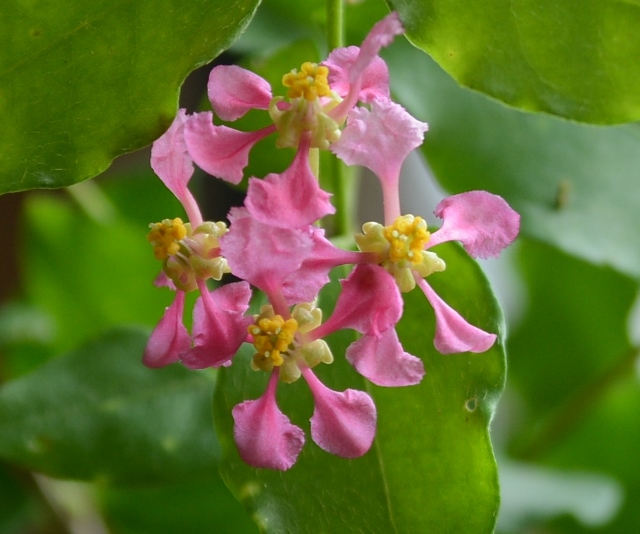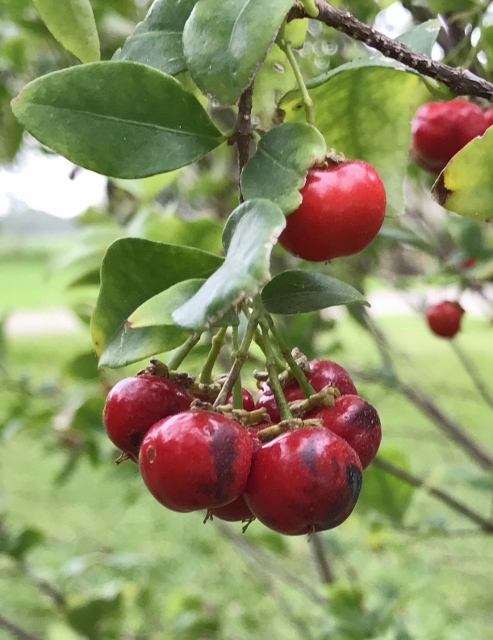
(Photo by Anita Westervelt.)

Versatile, nutritious and beautiful, native Barbados cherry is a great landscape addition
by Anita Westervelt, Texas Master Naturalist
Bring some Caribbean flavor to your Valley garden with a Barbados cherry, Malpighia glabra. This densely-branched shrub has many names in the Caribbean, West Indies and South America. In Cameron, Hidalgo, Starr and Willacy counties, its northern most native range, this attractive and multi-beneficial shrub also is known as Manzanita.
A popular, showy hedge plant in the Islands, where they flower and fruit nearly all year, it’s not uncommon for people to snag a couple of fruits to eat while walking along the neatly trimmed rows.
Here, Barbados cherry can be used as a hedge, or as a single shrub. If you have the space, a grouping of three or more makes an ornamental grove that will keep the birds happy. The shrubs can grow to six feet or taller spanning about four feet across and can handle an occasional pruning. With a very high heat tolerance, they do well in full or partial sun. They are susceptible to root-rot if not planted in well-drained soil. Once established, they require little maintenance.
Flowers begin blooming in spring and very soon form fruit. It will flower and fruit at the same time through fall. The slightly fragrant, orchid-like, light and bright pink flowers with yellow stamens attract butterflies. The shrub is a host plant for some Skipper butterflies.
The flowers are quite striking when the shrub is in full bloom. The flowers can be eaten raw or used to make tea, but the real prize is the glossy red fruit nearly a half inch in diameter.
The fruit is edible for humans. Barbados cherries are one of the richest sources of vitamin C. Less mature fruits have a greater vitamin C energy than riper fruit. Their ascorbic acid content is dependent upon various factors including how and where the plant is grown, how much sunlight it receives, and at what stage of ripeness the fruit is harvested as well as the individual plant’s genetic makeup.
Each fruit, technically called a drupe (fleshy fruits surrounding a hard pit or stone) has three small, rounded seeds with small fluted wings which give them a triangular appearance; two are larger than the third seed. The inedible seeds, or stones, are yellowish with a very hard corrugated leathery coat.
Historically, Barbados cherries have been used medicinally and commercially as well as in the home. The fruits can be stewed, made into juices, sauces, jellies, jams, preserves, purees, pies, ice cream and wine, as well as flavoring for cocktails. They also are used in making liqueurs.
Eaten fresh, the cherries may range in taste from sweet, tart or acidic. Juice is used commercially to enrich other fruit juices and fruit preserves low in vitamin C. In Brazil, the fruit has been used for wound healing and as nutritional support for convalescents.
The leaves stay green all year, which make this an attractive plant for a garden. A harsh winter may cause the leaves to fall, but leaf buds will begin to appear come spring. White tail deer sometimes eat the leaves and birds, raccoons and coyotes feed on the fruits.
The Rio Grande Valley Chapter, Texas Master Naturalist develops knowledgeable volunteers dedicated to the study and conservation of natural resources and natural areas in the Lower Rio Grande Valley and helps the natural world through service, outreach and education.
